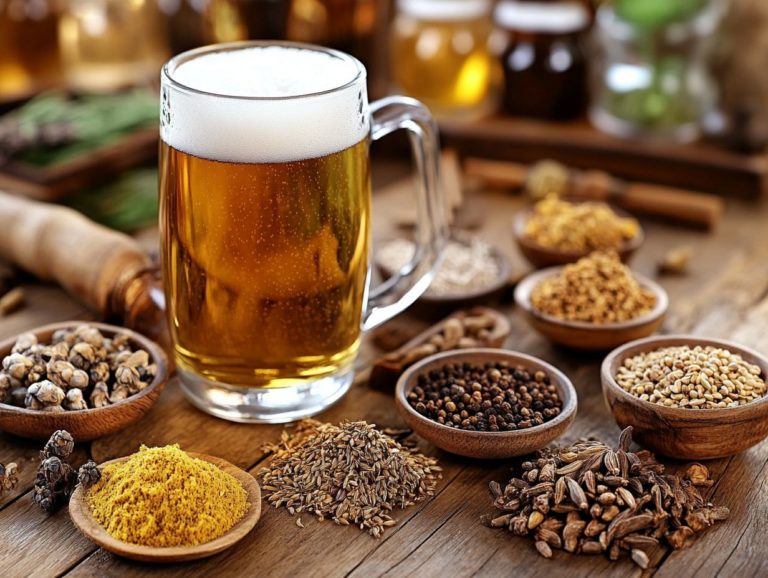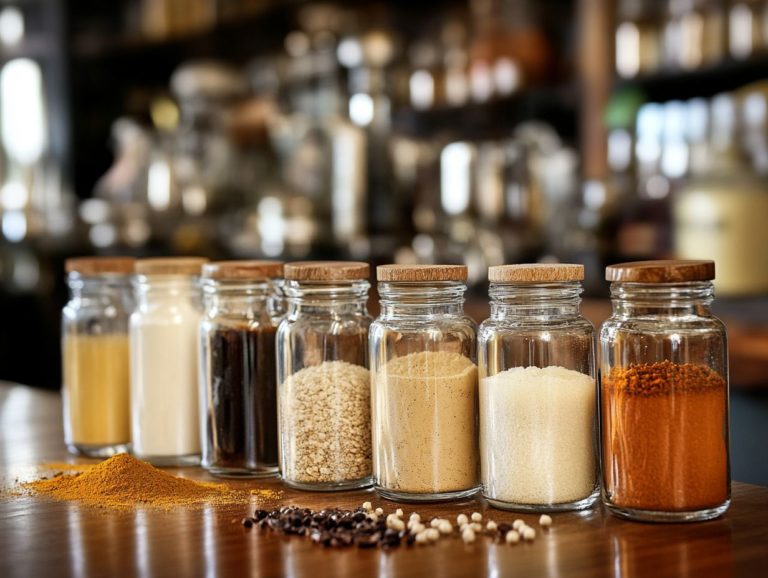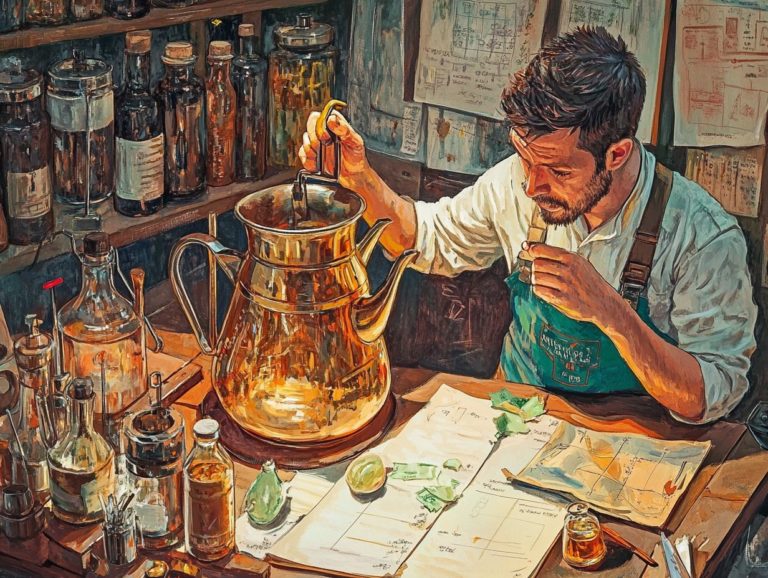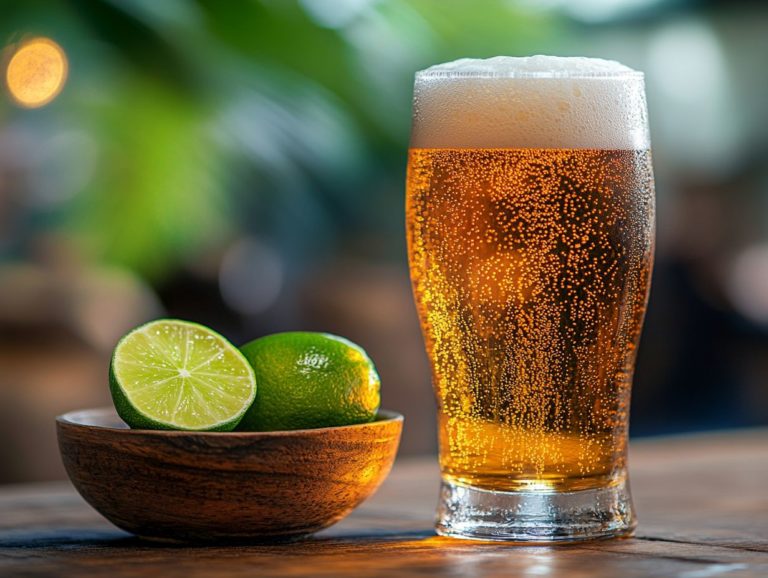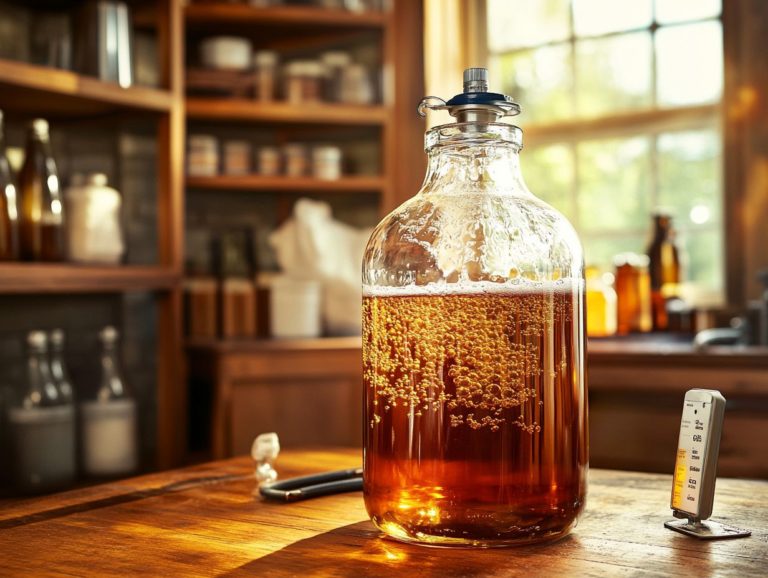How to Fix Bad Beer Head Retention
A frothy, stable beer head is the hallmark of a well-poured pint, enhancing both aroma and flavor in delightful ways. If you’ve ever watched your beer’s head disappear far too quickly, you’re certainly not alone in that frustration as a homebrewer.
Several factors can influence head retention, from the type of glassware you use to the carbonation levels in the beer itself. This article delves into the common causes of a lackluster beer head, presents effective testing methods, and offers practical solutions to ensure that every pour you enjoy is as satisfying as possible, whether you’re brewing an IPA, American Amber, or Dry Stout.
Prepare to elevate your beer experience to new heights with proper brewing techniques and ingredients like high alpha-acid hops and crystal malts!
Contents
- Key Takeaways:
- Causes of Poor Beer Head Retention
- How to Test Beer Head Retention
- 1. Pouring Technique for Optimal Head Retention
- 2. Visual Inspection and Sensory Evaluations
- 3. Smell Test
- How to Fix Bad Beer Head Retention
- How to Enhance Beer Head Retention
- 5. Consume Fresh Beer
- Tips for Maintaining Good Beer Head Retention
- Frequently Asked Questions
- What is beer head retention and why is it important?
- Why does my beer have poor head retention?
- How can I fix bad beer head retention?
- What is the role of carbonation in beer head retention and foam stability?
- Can the type of glassware affect beer head retention and foam stability?
- What other brewing techniques can I use to improve beer head retention?
Key Takeaways:
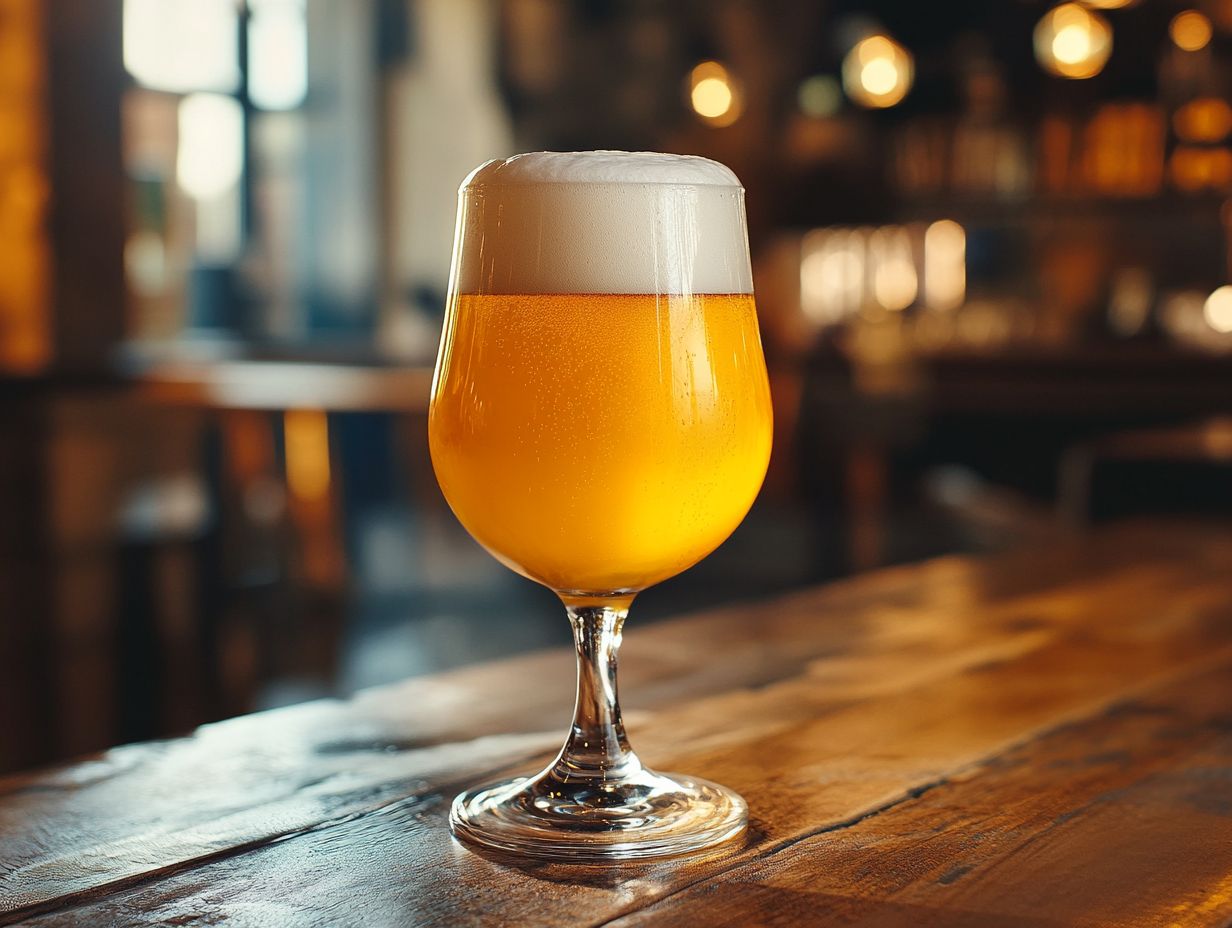
- Use proper glassware to ensure good beer head retention.
- Clean glassware properly to prevent any residue from affecting beer head retention.
- Adjust carbonation levels and reduce alcohol content to improve beer head retention.
Causes of Poor Beer Head Retention
Beer head retention is an essential quality indicator for you as a homebrewer, directly influencing both the visual appeal and flavor profile of your brew. Key factors include malt types, yeast activity, and proper sanitation.
Several factors can lead to poor foam stability, such as using the wrong glassware, inadequate cleaning techniques, and suboptimal carbonation levels during brew day.
To achieve a robust head on your hoppy beer, it s crucial for you to understand the brewing process and make informed ingredient choices, like selecting the right malt types, including wheat malt and CaraPils, and high alpha-acid hops. High alpha-acid hops are hops with a higher content of alpha acids, which contribute to bitterness and stability in beer. Yeast activity during fermentation also impacts head retention, as does your commitment to maintaining proper sanitation practices, such as using OxiClean for carboys and bottles.
1. Improper Glassware and Glass Cleanliness
Using improper glassware can significantly affect the head retention of your beer, making it crucial for you to choose the right type of glass and ensure its cleanliness to elevate your overall drinking experience.
Selecting the appropriate glassware is key to showcasing the unique characteristics of different beer styles. For example, a fine pilsner glass is crafted to highlight the clarity and effervescence of lagers, while a snifter enhances the aroma and warmth of richer ales like stouts and porters.
Don’t underestimate how crucial cleanliness is; it can make or break your beer experience! Residues can severely impede proper head formation, which is essential for preserving aroma and flavor. A spotless glass ensures that the beer s head remains stable and visually appealing, leading to a more pleasurable tasting experience.
Consider investing in a variety of glasses, such as tulip glasses for IPAs and wheat beers, to truly appreciate the subtleties of your craft.
2. Dirty Glassware and Proper Cleaning Techniques
Dirty glassware is one of the prime culprits behind lesser head retention in beer. Those pesky residues from inadequate cleaning techniques can really ruin the foam formation and stability, affecting the overall outcome of your brew.
To elevate your drinking experience, using the right cleaning agents and methods is absolutely essential. Techniques like soaking your glasses in warm water with OxiClean can work wonders, breaking down even the most stubborn beer residues. A thorough rinse with distilled water is a game-changer, washing away any potential contaminants and ensuring a pristine surface for your next brew.
And don t overlook the importance of sanitizing agents like Star San; they ensure that every surface is devoid of bacteria and unwanted odors. Implementing proper sanitation practices not only enhances the visual appeal of your beer but also plays a crucial role in the brewing process, preventing off-flavors and guaranteeing that every brew tastes just as it should.
3. Poorly Carbonated Beer and Its Impact on Foam Stability
The carbonation levels of your beer are vital for achieving impressive head retention. If your beer is poorly carbonated, you risk a disappointing lack of foam, which can detract from your overall drinking experience as a homebrewer. Proper bottle conditioning and the use of priming sugar are crucial steps.
To reach your desired level of carbonation, consider employing bottle conditioning. This technique involves using priming sugar. By meticulously calculating the amount of sugar based on the style of beer and its temperature, you can influence the amount of carbon dioxide produced by the yeast during fermentation in the bottle. This is essential for creating delightful bubbles that enhance carbonation.
The extra yeast activity generates those delightful bubbles, enhancing carbonation. Keep in mind that the strain of yeast you choose can significantly impact both carbonation levels and foam stability. A robust yeast strain creates a stronger head, while a less active one may fail to deliver the carbonation you need for that perfect finish.
Grasping these dynamics is essential for crafting the ideal brew, whether it’s a hoppy IPA or a rich stout.
4. High Alcohol Content and Its Effects
High alcohol content in beer can significantly affect head retention, causing the foam to be thinner and influencing the overall flavor profile of the brew.
This phenomenon stems from specific brewing techniques, especially during the fermentation process when high-attenuation yeast strains are employed. These strains concentrate sugars and alcohol, resulting in elevated alcohol levels. Variations like specialty malts or adjuncts can boost alcohol content but may inadvertently compromise the protein structure crucial for maintaining stable foam. The use of specialty ingredients like CaraPils can help in these scenarios.
Brews with significant alcohol levels may present a less robust head, diminishing the aromatic experience and altering the mouthfeel. These changes vary across different styles, leading to unique sensory experiences that challenge traditional expectations and cater to adventurous palates.
5. Aging Beer and Head Retention
Aging beer can significantly alter its head retention characteristics. While some aging enhances flavor complexity, it may also lead to reduced foam stability, much to the dismay of dedicated beer enthusiasts.
This becomes especially evident when considering the types of malts used in the brewing process. Each malt variety, from pale to caramel, presents its unique sweetness profile and color contribution, both of which evolve as the beer matures. As these malts interact with oxygen over time, their impact on the beer’s viscosity and foam structure shifts, influencing how well the beer retains its head.
Don’t overlook the role of hop bittering; as hops age, their aroma diminishes, potentially leaving behind a bitterness that alters the perception of mouthfeel and foamy head. These dynamic interactions highlight the complexity of the aging process and its implications for beer enthusiasts, who seek specific characteristics in their brews. The influence of Zymurgy articles can also offer valuable insights into the aging process and ingredient use.
How to Test Beer Head Retention
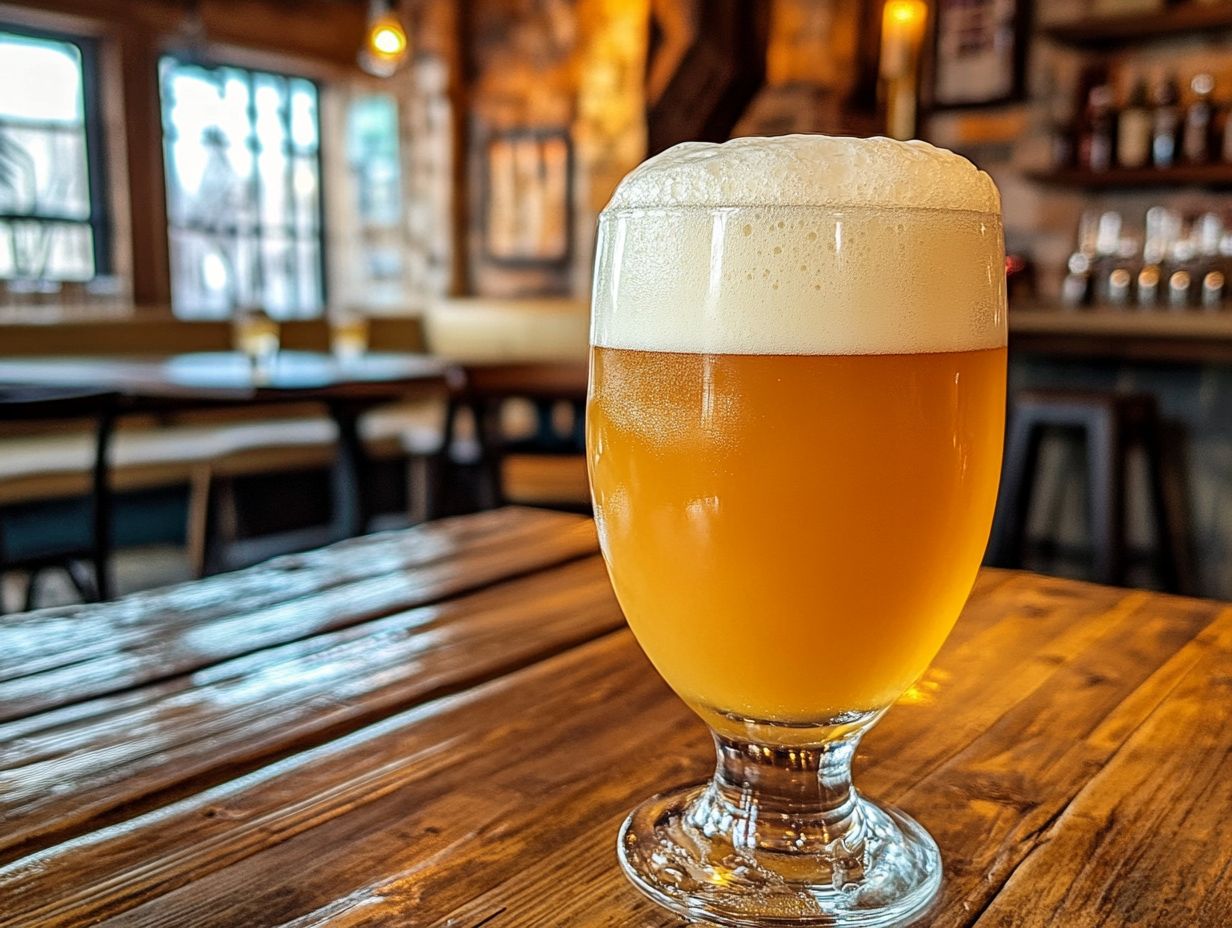
Testing beer head retention is crucial for any homebrewer aiming to refine their brewing skills. It encompasses a blend of pouring techniques, visual inspection, and sensory evaluations, including the all-important smell test.
Try these methods on your next batch and see the difference in head retention!
1. Pouring Technique for Optimal Head Retention
The pouring technique is essential for achieving optimal beer head retention, significantly influencing foam stability and the beverage’s overall presentation. Proper pouring can make a substantial difference on brew day.
To truly master this art, consider several key aspects when pouring your beer:
-
Start by holding your glass at a 45-degree angle, allowing the beer to flow gently down the side. This minimizes excessive agitation and sets the stage for a perfect pour.
-
As the glass fills, gradually tilt it upright, stopping just short of full to create the ideal space for foam formation.
-
The height from which you pour is crucial; aiming for about 4-6 inches can help you develop a rich head, provided the glass is pristine and free from any residues that might compromise the foam’s integrity.
A cleaner glass leads to better foam stability, resulting in an inviting appearance that elevates your entire drinking experience.
2. Visual Inspection and Sensory Evaluations
A visual inspection of the beer can reveal a wealth of information about its head retention qualities. The appearance of the foam offers clues about its stability and overall quality. This inspection helps refine your brewing techniques.
When you conduct a thorough examination, pay close attention to the size and density of the foam. Also, note its longevity. A thicker head with a finer texture often points to a higher level of proteins and sugars, which positively contribute to the beer’s stability. Take note of how long the foam lingers after pouring, as this provides valuable insights into the fermentation and carbonation processes.
The interplay of these characteristics serves as an indicator of the brewing technique and enhances your overall drinking experience, offering sensory engagement that many aficionados truly appreciate.
3. Smell Test
Conducting a smell test is an essential part of assessing beer quality. It enables you to evaluate the flavor profile and freshness, which can indirectly impact head retention. Smell tests can be particularly revealing for different styles, be it an IPA or a stout.
Get ready to be amazed by the delightful bouquet that awaits you! By taking a moment to inhale the bouquet emanating from your glass, you ll uncover a delightful array of scents, ranging from floral notes to hints of citrus, and even the robust aroma of roasted malts. It s crucial to pay attention to whether these aromas are vibrant and inviting; stale or unpleasant smells often signal a lack of freshness that can significantly diminish your overall drinking experience.
Freshness is vital for flavor and impacts the visual allure and persistence of the beer s head. A well-retained head enhances your experience, providing both aromatic pleasure and carbonation retention, ensuring that every sip is nothing short of enjoyable. This is especially true for hoppy beer styles like IPA, where hops contribute significantly to aroma and flavor.
How to Fix Bad Beer Head Retention
To enhance beer head retention, adopt a comprehensive approach as a homebrewer. This involves:
- Selecting the right glassware.
- Employing effective cleaning techniques.
- Adjusting carbonation levels.
- Enjoying your beer while it s still fresh.
Proper sanitation during the brewing process is also crucial to prevent off-flavors that can affect foam stability. Each of these elements plays a crucial role in achieving that perfect pour and rich, lasting head that elevates your brewing experience. Using high-quality malt types, such as crystal malts and CaraPils, can significantly improve protein levels in your beer, contributing to better head retention.
Now it’s time to apply these tips and enjoy the results! Share your brewing experiences and let others know how you achieved better head retention.
How to Enhance Beer Head Retention
1. Use Proper Glassware
Using the right glassware is essential for enhancing beer head retention. It allows you to truly showcase your beer’s foam stability and enticing aroma.
Different beer styles benefit from specific types of glassware, as each design influences the overall drinking experience. For example, a tulip glass is perfect for complex beers with rich aromas; its inward-curving rim traps scents and elevates the olfactory delight. While a pint glass is often the go-to for lighter ales, it may not always preserve the head very well.
For wheat beers, a weizen glass is a fantastic choice. It allows for ample foam formation, enhancing taste perception and creating a visually appealing presentation. By selecting the right glass, you promote the beer’s natural characteristics, leading to a much more enjoyable drinking experience.
2. Clean Glassware Properly
Properly cleaning your glassware is essential for achieving optimal beer head retention. It prevents residues that might sabotage foam stability and flavor.
To ensure the best results, begin by rinsing the glass with warm water to wash away any leftover beer or foam. Next, use gentle dish soap or a specialized cleaner like OxiClean. Scrub both the interior and exterior of the glass with a soft sponge to eliminate stubborn stains and lingering odors.
Once you’ve finished scrubbing, it s crucial to thoroughly rinse the glass with warm water to avoid any soap residue that could impact the taste of your beer. Finally, air dry the glass upside down on a clean drying rack to keep it sanitized and dust-free, safeguarding the integrity of your brewing process.
3. Adjust Carbonation Levels
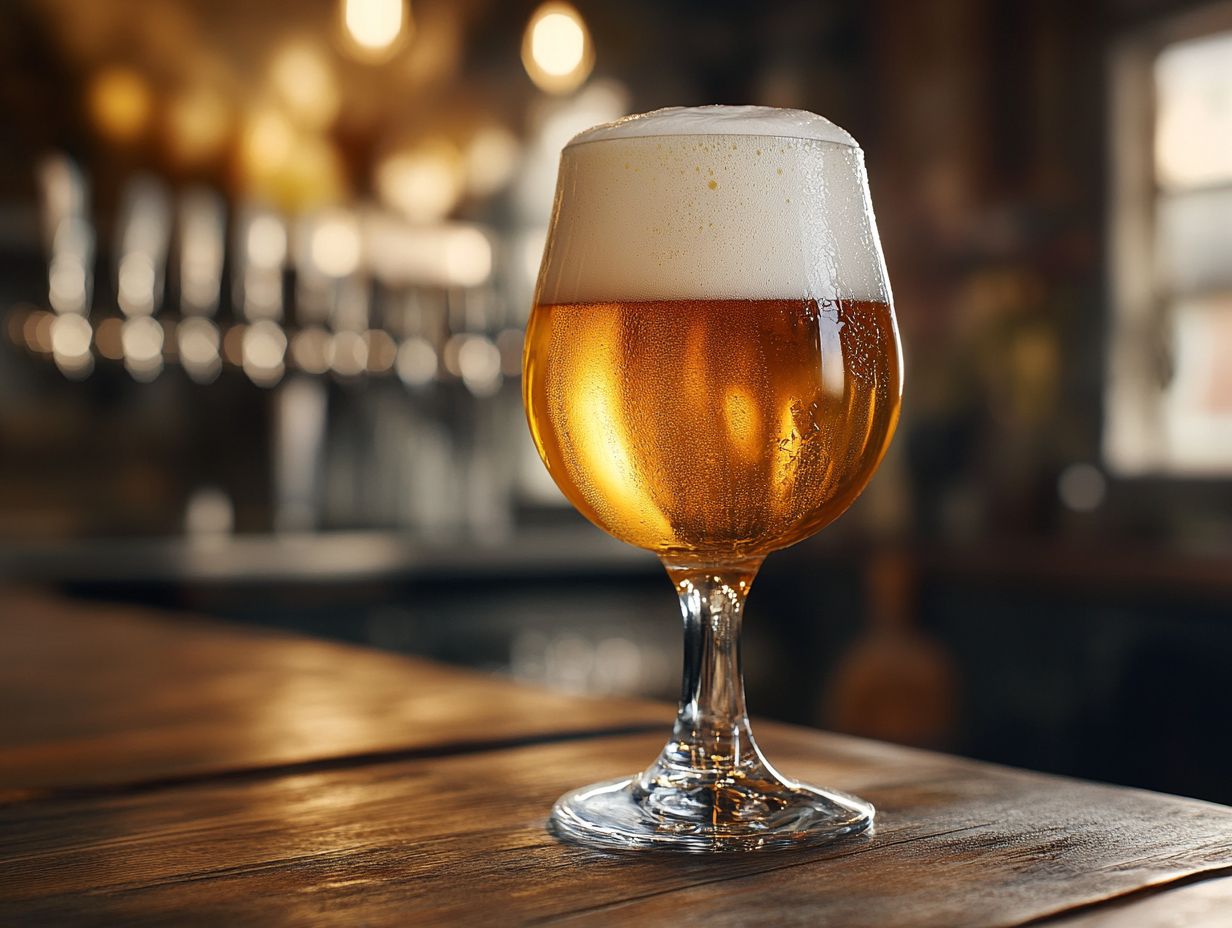
Adjusting carbonation levels is a crucial strategy for enhancing beer head retention. This helps you strike the perfect balance between CO2 and foam stability.
Recognizing the role of priming sugar, which is the sugar added to beer for carbonation, is essential. When you add sugar before sealing the bottles, it ferments and produces carbon dioxide, resulting in carbonation. Keeping an eye on yeast activity is vital, as varying temperatures and conditions can greatly influence how effectively the yeast consumes the sugar.
This impacts the overall carbonation level and plays a significant role in the flavor and mouthfeel of your finished brew. By carefully calculating the right amount of sugar usually guided by the beer style and your desired carbonation levels you ll create the perfect fizz. This ensures each bottle delivers a satisfying pour with a delightful head. Effective monitoring of yeast activity during bottle conditioning is also key to achieving consistent results.
4. Reduce Alcohol Content
Reducing the alcohol content in beer can significantly enhance head retention. This results in improved foam stability and a more pleasurable flavor profile. This is particularly important for certain beer styles like American Amber and Dry Stout, where a balanced flavor profile is essential.
You can achieve this adjustment through various brewing techniques, such as using lower fermentable sugars, fine-tuning the mash temperature, or selecting specialized yeast strains. By lowering the fermentation potential, you ensure that the beer maintains a creamy, thicker foam, elevating the overall drinking experience.
A lower alcohol level often brings forth a more nuanced flavor profile, allowing you to fully appreciate the intricate balance of hops and malt. As a result, both seasoned enthusiasts and casual drinkers can enjoy a refreshing beer without the heaviness that often accompanies higher alcohol content.
5. Consume Fresh Beer
Consuming fresh beer is crucial for achieving great foam. As beer ages, both its stability and flavor profile can deteriorate, adversely affecting the foam.
The robust carbonation that gives beer its lively character diminishes over time, resulting in a flat texture that can significantly detract from your overall drinking experience. For homebrewers, grasping this timeline is vital it ensures that your beer reaches its enthusiasts at the peak of freshness.
To effectively manage your inventory, consider labeling each bottle with the bottling date and implementing a first in, first out system. By storing your beer in cool, dark environments, you can maintain its quality, preserving the delightful aromas and flavors that make each brew a unique and enjoyable experience.
Tips for Maintaining Good Beer Head Retention
To achieve excellent beer head retention, focus on several key factors that elevate the quality of your brews.
This includes ensuring proper storage, selecting the ideal serving temperature, and mastering the art of pouring techniques. Each of these elements plays a vital role in presenting your beer at its very best.
1. Store Beer Properly
Properly storing your beer is crucial to keep it fresh and ready for enjoyment! It preserves freshness and ensures optimal head retention, allowing the flavors to develop beautifully over time.
Temperature control is key in this process. Keeping your beer in a consistent, cool environment helps maintain the intended sensory experience, preventing off-flavors that can emerge from heat fluctuations. Store your beer at about 45 to 55 degrees Fahrenheit, depending on the style, as these temperatures complement the carbonation and enhance the aroma.
Minimizing light exposure is crucial especially when it comes to ultraviolet light, which can cause your beer to skunk and alter its taste. Proper storage in dark environments is as important as the fermentation process, where factors like the use of carboys and the selected yeast strains impact the end result.
By adhering to these best practices, you can enjoy a fulfilling experience with every pour, characterized by vibrant flavors and stable foam that elevate both the visual appeal and overall enjoyment of your beer.
2. Serve Beer at the Right Temperature
Serving beer at the right temperature is essential for enhancing both its flavor profile and head retention, allowing you to fully appreciate the beer’s character.
Different beer styles thrive at various temperatures, each unlocking unique aromas and flavor notes that might otherwise remain hidden. For example, lighter lagers and wheat beers shine when served chilled, ideally between 38-45 F, which highlights their refreshing qualities and crispness. On the other hand, darker ales and complex stouts are best enjoyed at a warmer temperature, around 50-55 F, bringing forth rich notes of chocolate and caramel. Understanding how different malt types, such as wheat malt and specialty grains, interact with temperature can further enhance your flavor profile.
The temperature also plays a significant role in foam characteristics. Colder beers often produce a tighter, more stable head, while warmer selections encourage a softer, creamier texture. By understanding these nuances, you can elevate your beer-drinking experience, savoring each sip in its most optimal state.
3. Avoid Aggressive Pouring
Avoiding aggressive pouring is essential for achieving remarkable head retention. A gentle pour not only promotes foam stability but also elevates your overall drinking experience.
When you pour at a consistent angle typically around 45 degrees and maintain a controlled speed, the liquid cascades effortlessly into the glass, significantly aiding in the creation of a robust foam layer. This technique prevents excessive agitation, allowing carbon dioxide to escape gracefully, which fortifies the bubbles of the foam.
On the flip side, pouring too quickly or at a more upright angle can lead to a chaotic foam formation that dissipates rapidly, undermining the enduring head you desire. By mastering these pouring techniques, you ll end up with a drink that boasts exceptional visual appeal and aroma, inviting you to savor every exquisite sip.
Frequently Asked Questions
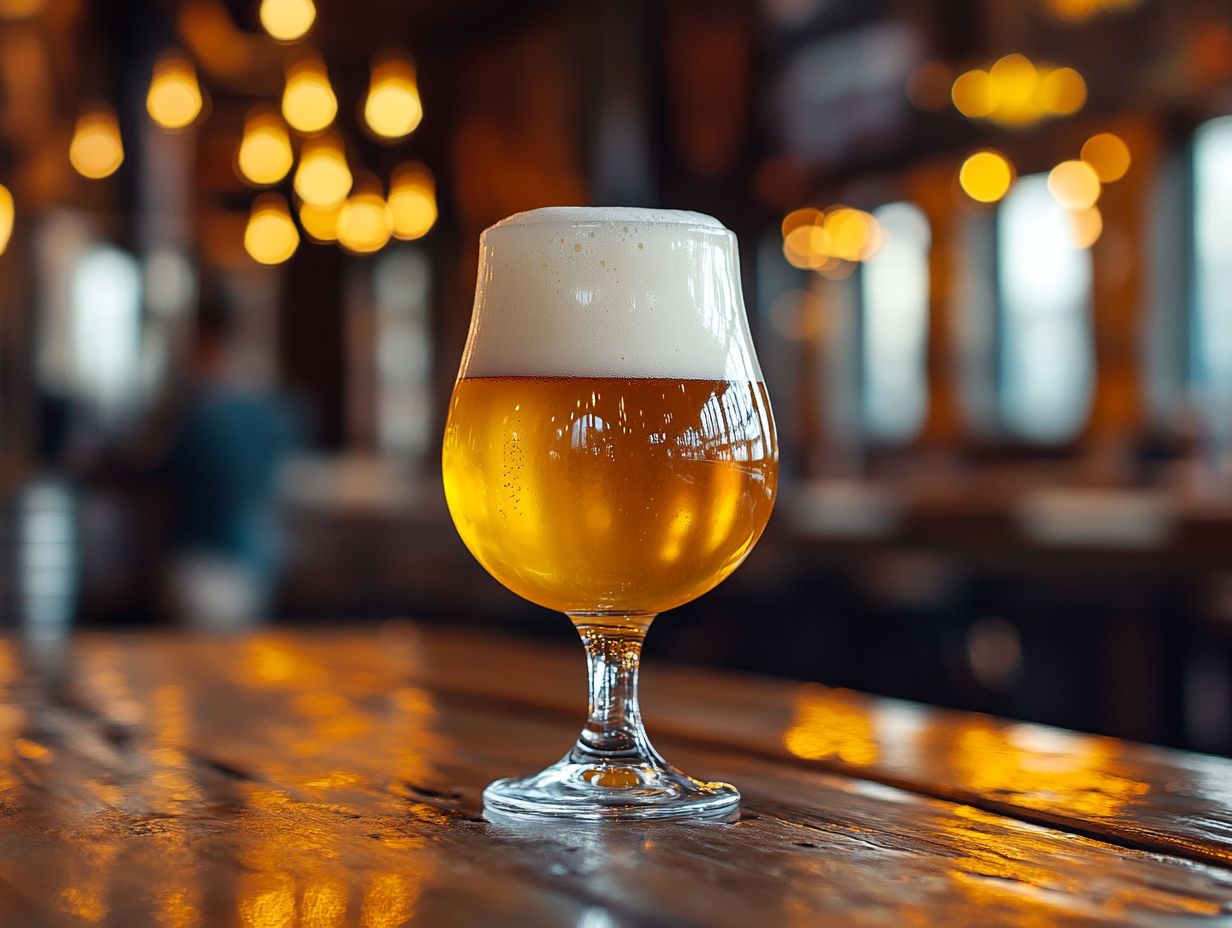
What is beer head retention and why is it important?
Beer head retention is the term used to describe the foam or froth on top of a beer. It is important because it affects the appearance, aroma, and taste of the beer. Additionally, it can indicate the level of carbonation and quality of the brew.
Why does my beer have poor head retention?
Poor head retention can be caused by a variety of factors, such as using dirty glasses or improper pouring techniques. Other common causes include using improper ingredients or brewing techniques, or storing the beer for too long.
Ensuring proper sanitation and maintaining protein levels through the use of appropriate malt types like CaraPils can help improve foam stability.
How can I fix bad beer head retention?
Adopting good brewing practices, such as choosing the right malt types and ensuring proper carbonation, can greatly improve head retention. Maintaining glass cleanliness is also essential.
Another method is to use specialty malts, such as caramel or crystal malts and CaraPils, which contain proteins that can help stabilize the foam. Adding adjuncts like wheat or flaked barley can also increase the protein content of the beer.
Homebrewers often pay attention to these details during the brewing process to ensure better foam stability.
What is the role of carbonation in beer head retention and foam stability?
Carbonation is a key factor in head retention. The carbon dioxide bubbles in the beer help to form and maintain the foam. Ensuring the proper level of carbonation is important because too much or too little can result in poor head retention.
Pay attention to the carbonation levels during the brewing process, especially if you are using priming sugar for bottle conditioning.
Can the type of glassware affect beer head retention and foam stability?
Yes, the type of glassware used can have a significant impact on head retention. Certain glass shapes, such as tulip or pilsner glasses, are designed specifically to enhance head retention by allowing the foam to form and cling to the sides of the glass.
Ensuring glass cleanliness and proper sanitation with OxiClean can also help maximize head retention.
What other brewing techniques can I use to improve beer head retention?
Using specialty malts and choosing the right glassware can improve head retention. Proper cleaning and sanitizing of glassware, avoiding excessive oils or detergents, and ensuring the correct temperature for serving the beer are also beneficial.
Utilizing proper brewing techniques, such as managing protein levels with malt types like wheat malt, and understanding the impact of yeast activity and hop bittering during fermentation can contribute to better head retention.

